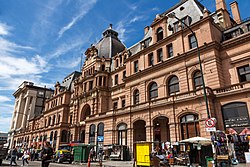Constitución railway station
|
Plaza Constitución
|
|
|---|---|
| Commuter and inter-city rail | |

The front of the station.
|
|
| Location | Av. Brasil 1128, Constitución, Buenos Aires Argentina |
| Owned by | Government of Argentina |
| Operated by |
Trenes Argentinos Ferrobaires |
| Line(s) | Roca |
| Connections |
Underground |
| Construction | |
| Platform levels | 16 |
| History | |
| Opened | 1865 |
| Electrified | Overhead line |
Constitución railway station (Spanish: Estación Constitución) is a large railway station Barrio Constitución in central Buenos Aires, Argentina. The full official name of the station is Estación Plaza Constitución (in English: Constitution Square Station) reflecting the fact that the station is located opposite Constitution Square, two kilometers to the south of the Obelisco landmark. The ground floor of the station has fourteen tracks and the floor below has two tracks for the Buenos Aires Underground.
On 7 March 1864, in a ceremony attended by the president Bartolomé Mitre, construction began at Mercado Constitución, on the site of the present day terminus, as the British-owned Buenos Aires Great Southern railway company began building its first broad gauge line of 114 km as far as Chascomús. The first section of the line to Jeppener, Buenos Aires, was opened on 14 August 1865; during that same month a small terminal station at Mercado Constitución was opened to the public and renamed Plaza Constitución. Later that year in December the line to Chascomús was opened.
Between 1885 and 1887 the Plaza Constitución terminus was rebuilt and enlarged and between 1906 and 1907 further building work was carried out and extra platforms were added to cope with the increasing suburban traffic. In 1912 yet more platforms were added.
On 19 September 1925 a foundation stone for the present day terminus was laid by the Prince of Wales, later Duke of Windsor, during his official visit to Argentina. The original station was then rebuilt with fourteen platforms roofed over, modern hydraulic buffer stops and an imposing concourse which formed a massive main hall, one of the largest in the world, along the entire length of the site. Of the fourteen platforms, only two or three were normally used for mainline trains, leaving the rest for suburban services. To the east of the main station a large goods and parcels section with warehouses, offices and several sidings was built. The street frontage of the original station was left untouched due to financial constraints imposed towards the end of the rebuilding.
...
Wikipedia
